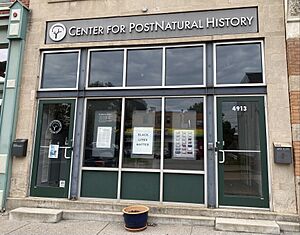Center for PostNatural History facts for kids

Front of the Museum in 2022
|
|
| Location | 4913 Penn Avenue Pittsburgh, Pennsylvania 15224 |
|---|---|
| Founder | Richard Pell |
| Nearest parking | On street |
The Center for PostNatural History is a special museum in Pittsburgh's Garfield neighborhood. Unlike typical natural history museums, this museum focuses on living things that humans have changed on purpose. These changes can be through things like selective breeding or genetic engineering. This idea is called the postnatural.
The Center wants to help people learn about how humans, nature, and new technologies mix together. Its goal is to collect and show organisms that have been changed by humans.
Contents
How the Museum Started
The museum was started by Richard Pell. He is a professor at Carnegie Mellon University.
Cool Exhibits to See
The museum shows many interesting exhibits. These include:
- GloFish: These are fish that glow! They have genes from sea coral added to them.
- Biosteel Goats: These goats can grow spider silk proteins in their milk. This is a special kind of protein.
- Transgenic Fruit Flies: These are fruit flies that have had their genes changed.
- Silkie Chicken: This chicken was bred to have very fluffy, fur-like feathers.
How Exhibits Are Shown
When you visit, you can listen to stories about the exhibits using wired telephone handsets. The museum uses different ways to show things. You might see photographs, stuffed animals (taxidermy), or even living creatures.
The Center also has a large online collection. It shows past and current exhibits, specimens, and news.
Past Special Exhibitions
Some past exhibits include:
- Cold Coast Archive: This showed items and seeds from the Svalbard Global Seed Vault. This vault stores seeds from all over the world.
- Atomic Age Rodents: This exhibit featured rodents that were part of atomic testing long ago.
- PostNatural Nature: This exhibit looked at how "postnatural" changes appear in everyday living things. It was made with the Museum für Naturkunde in Berlin.
The museum also creates exhibits that travel to other museums and galleries. These have been shown in places like Amsterdam and Berlin.
Museum Design and Message
The Center for PostNatural History uses a careful and thoughtful way to display its exhibits. It uses simple and neutral words to describe things. This helps visitors think deeply about the specimens and ideas. The museum wants people to understand how different lives can exist together. It asks what is important for living things, places, and ideas.
The Center also sells items related to its collections. You can find books, T-shirts, postcards, and 3D prints.
In the News
In 2015, the Center was featured in National Geographic magazine. It was part of their March 2015 issue.

